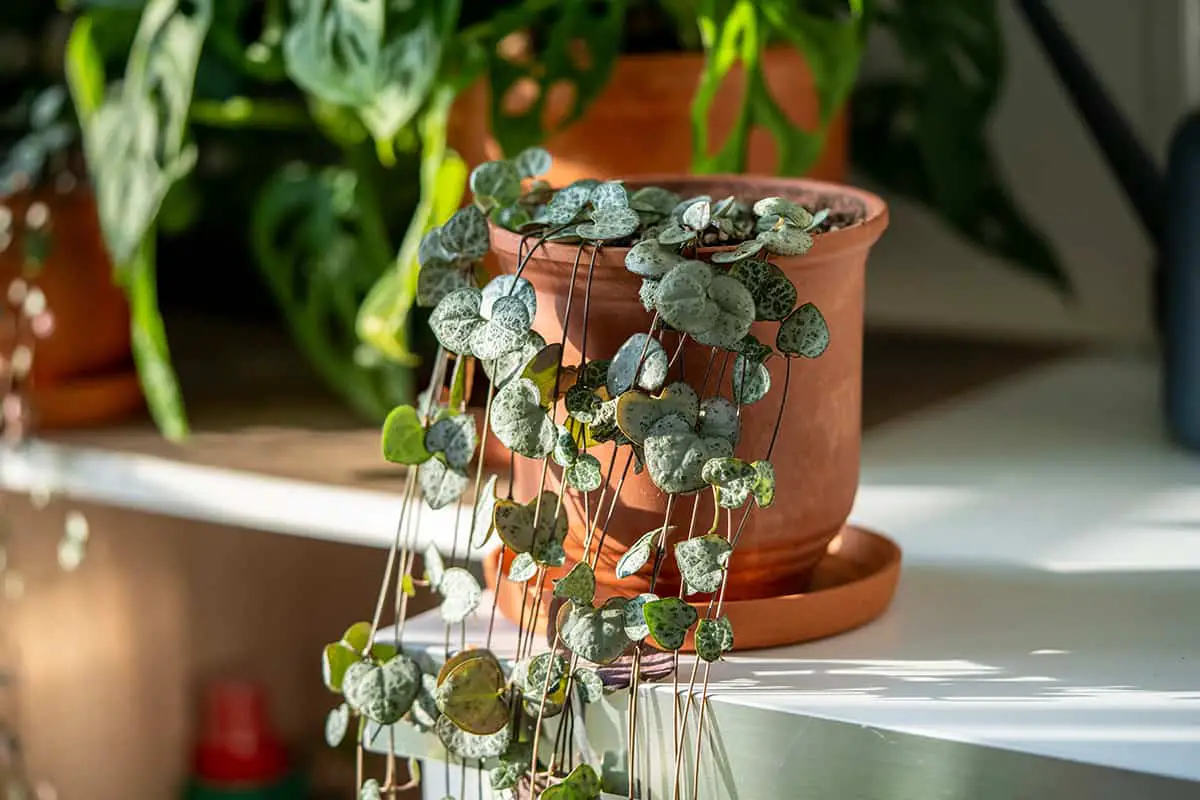After a long day, you retreat to your quiet corner at home to unwind, but the air feels heavy and slightly damp. To combat this, introducing trailing houseplants like Pothos or Boston Ferns can make a world of difference. These plants not only absorb excess moisture but also add a lively touch of green that enhances your relaxation space. Let’s explore 20 magnificent trailing houseplants you can easily add to your home.
Table of Contents
- Pothos (Epipremnum Aureum)
- Spider Plant (Chlorophytum Comosum)
- String Of Pearls (Senecio Rowleyanus)
- English Ivy (Hedera Helix)
- Heartleaf Philodendron (Philodendron Hederaceum)
- Tradescantia Zebrina (Tradescantia Zebrina)
- String Of Hearts (Ceropegia Woodii)
- Golden Pothos (Epipremnum Aureum ‘Aureum’)
- Swiss Cheese Plant (Monstera Adansonii)
- Boston Fern (Nephrolepis Exaltata)
- Peperomia Prostrata (String of Turtles)
- Satin Pothos (Scindapsus Pictus)
- Chain Of Hearts (Ceropegia Woodii Variegata)
- Hoya (Hoya Carnosa)
- Burro’s Tail (Sedum Morganianum)
- Rhipsalis (Rhipsalis Baccifera)
- Arrowhead Plant (Syngonium Podophyllum)
- Maidenhair Vine (Muehlenbeckia Complexa)
- Wandering Jew (Tradescantia Pallida)
- String Of Nickels (Dischidia Nummularia)
Pothos (Epipremnum Aureum)

You might be familiar with Pothos, a popular and easy-to-grow trailing houseplant. It is also known as Devil’s Ivy and native to the Solomon Islands. Pothos belongs to the tropical climbing vine species and has heart-shaped leaves. The leaves exhibit green color with white or yellow variegation, making it visually appealing.
Pothos adapts well to a wide range of lighting conditions, from low light to indirect sunlight. Please note that direct sunlight can lead to leaf burn. Your Pothos will grow well in temperatures between 65°F and 85°F, and it can tolerate occasional temperature fluctuations.
When it comes to watering, allow the top inch of the soil to dry out before rewatering. Overwatering can cause root rot and attract pests. Pothos isn’t demanding when it comes to humidity, but if you want to give it a boost, you can mist the leaves regularly or place the plant on a tray with pebbles and water.
To achieve healthy growth, you need to fertilize your Pothos. Use a balanced, water-soluble houseplant fertilizer, applying it every 4-6 weeks during the growing season. Remember to stop fertilizing in the winter months, as Pothos goes into rest mode.
Maintain your Pothos by pruning its vines to control its growth and encourage bushy growth. When you trim your plant, don’t throw the cuttings away! You can propagate Pothos from these cuttings by placing them in water or soil, giving you even more beautiful trailing houseplants.
Spider Plant (Chlorophytum Comosum)
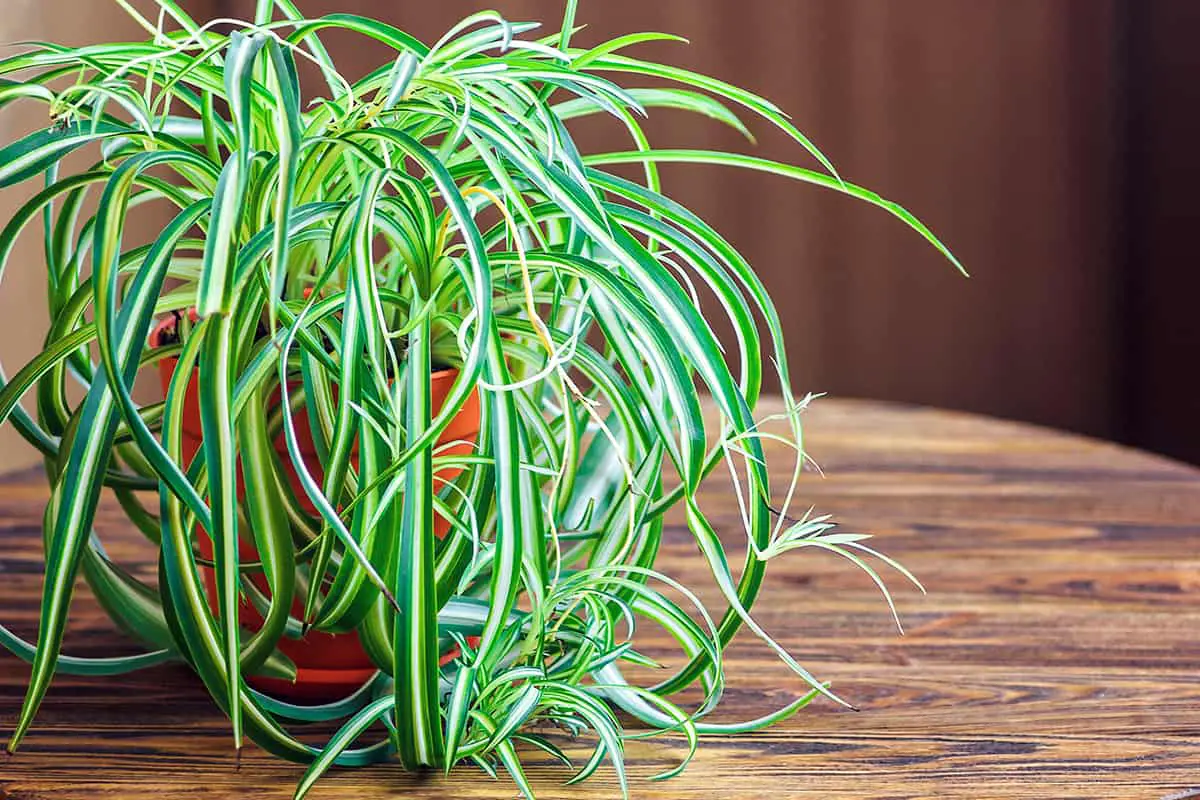
The Spider Plant, or Chlorophytum Comosum, is an attractive and popular choice among trailing houseplants. Its common name comes from the small plantlets it produces on long trailing stems, resembling spiders.
There are different varieties of Spider Plants, with most showcasing a white or yellow stripe down the center of the leaves, and the ‘Vittatum’ being the most commonly seen. When grown in hanging baskets, these eye-catching plants can grow to be 2 to 3 feet long. In addition to their aesthetics, Spider Plants are valued for their ease of propagation.
Spider Plants are known for their tolerance to neglect but will certainly thrive under proper care. Ensure that your Spider Plant gets sufficient indirect light, as direct sunlight may damage the foliage. When it comes to watering, take care not to overwater these plants, as they can be sensitive to root rot. Allow the soil to dry out slightly before the next watering session.
Another notable feature of the Spider Plant is its air-purifying abilities. It effectively removes various pollutants from the air, making it an excellent addition to your living space.
String Of Pearls (Senecio Rowleyanus)

You may be interested in the String of Pearls, a distinctive trailing houseplant. This unique succulent plant, scientifically known as Senecio Rowleyanus, originates from South Africa. Displaying almost spherical leaves, this plant is perfect for embellishing your indoor space.
When growing String of Pearls, provide them with bright, indirect light, and let the potting mix dry between waterings. You’ll need to be careful not to overwater, as succulents are susceptible to root rot. Regarding the soil, use a well-draining mixture specifically for succulent plants.
The String of Pearls can thrive in a hanging basket, which allows its beautiful trailing stems to cascade. In addition to its visual appeal, this plant can grow relatively fast, up to 5 to 15 inches per year, offering ample coverage. Periodic pruning helps keep the plant compact and encourages lush growth.
English Ivy (Hedera Helix)
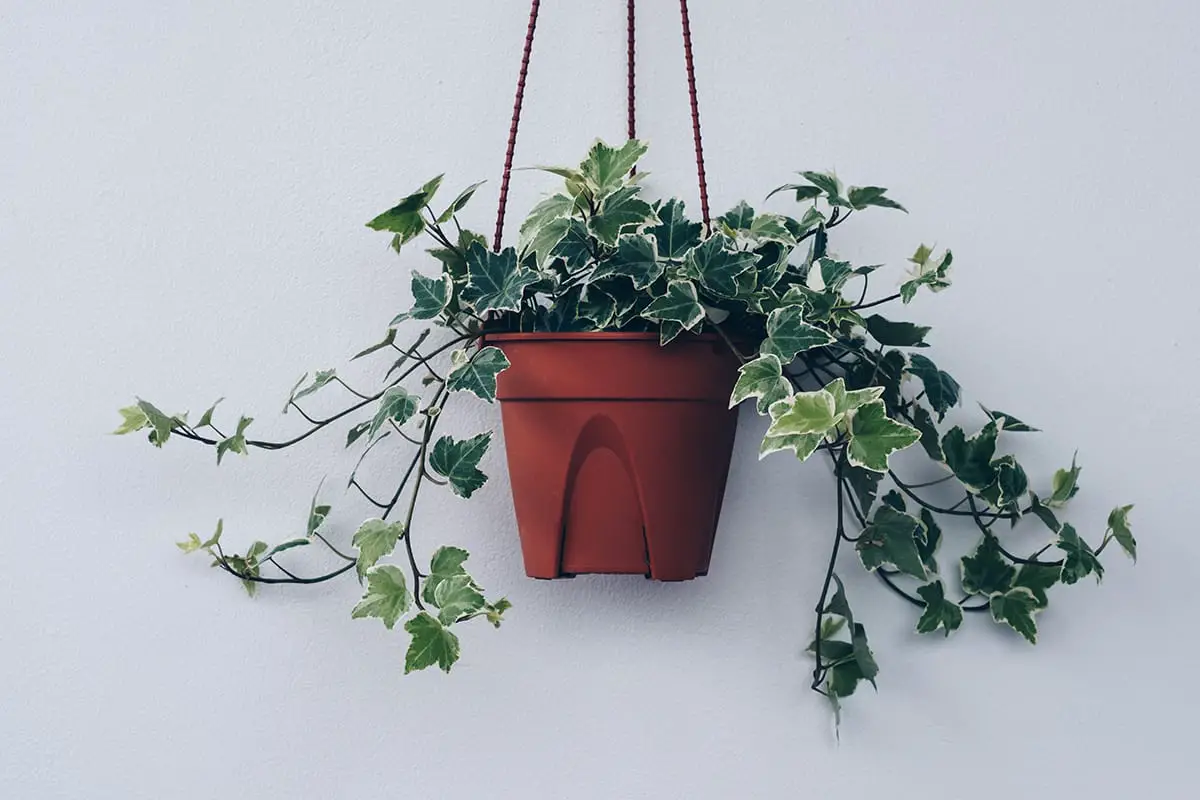
English Ivy is a popular choice when it comes to trailing houseplants. This evergreen, invasive vine can be an excellent addition to your indoor garden. Due to its versatility, it can be grown in hanging baskets, alongside other plants, or even trained on trellis frames for decorative purposes.
To care for your English Ivy, make sure you provide it with the right conditions. When grown inside, it thrives in partial to full shade, typically prefers rich, acidic soil, and needs adequate drainage. Regular watering is crucial to maintain its growth, along with proper humidity to avoid issues with spider mites or foliage drying out.
As a fast-growing houseplant, English Ivy requires some occasional maintenance, including pruning, which not only helps keep the vine under control but also stimulates new growth. Make sure to keep an eye on the roots, as the plant tends to create new growth at the nodes, making it susceptible to being pot-bound.
Despite being a beautiful indoor plant, English Ivy has some potential drawbacks. It is considered an invasive plant mainly due to its rapid growth habit and ability to climb, as well as its potential to cause damage to walls and structures when planted outdoors. To prevent it from spreading, you need to keep it well-groomed and contained in an indoor setting.
Heartleaf Philodendron (Philodendron Hederaceum)
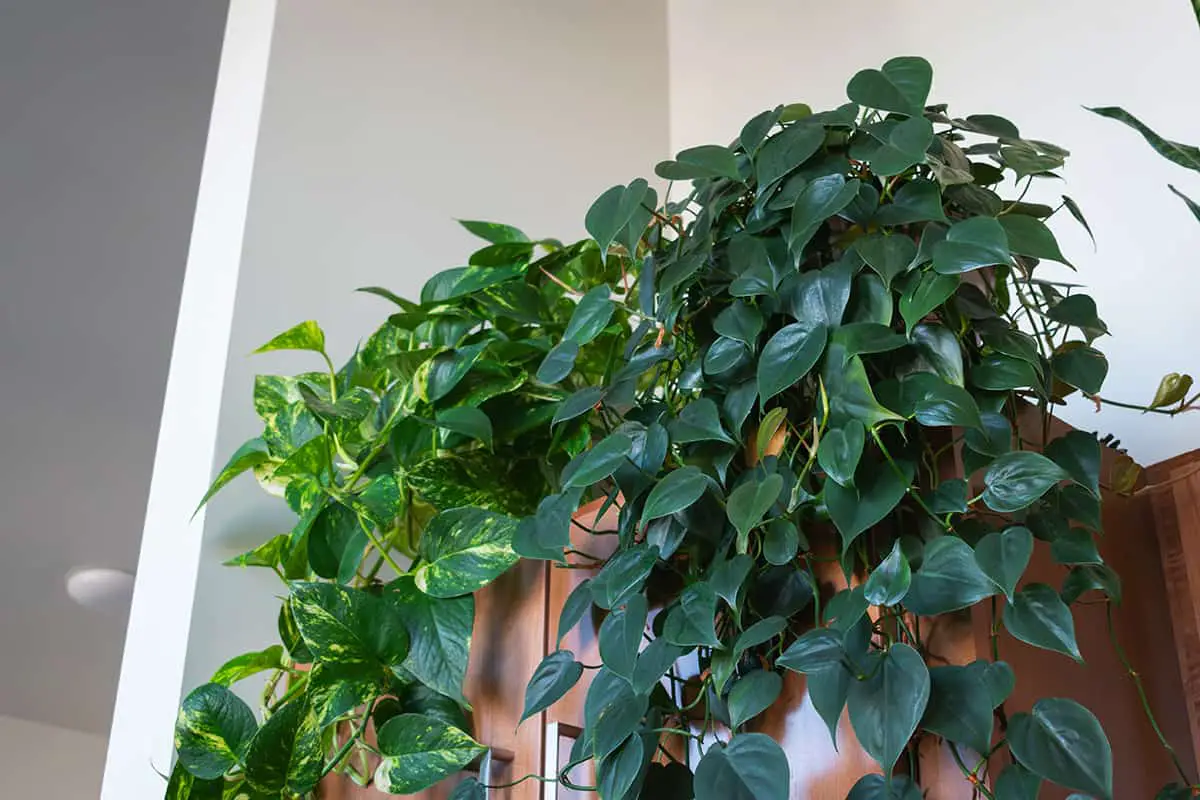
Quickly introducing, the Heartleaf Philodendron (Philodendron hederaceum) is a popular vining houseplant. Its appeal lies in its glossy green heart-shaped leaves on cascading stems. This easy-to-grow plant adapts well to indoor conditions, making it perfect even for beginners.
Knowing how to care for your Philodendron is essential. Always remember to provide evenly moist soil, but never too wet. Water the plant when the top of the soil is dry, avoiding any excess water in saucers. Consistency is key to avoid harming your plant.
When it comes to lighting, this tropical evergreen does best in low light conditions. However, it can tolerate a mix of bright and indirect light as well. Finding the ideal spot in your home is crucial for the Heartleaf Philodendron’s optimal growth.
Temperature and humidity also affect your plant’s growth. The Heartleaf Philodendron prefers consistent temperatures between 65 to 80 degrees Fahrenheit, while high humidity levels are ideal but it can adjust to the low-humidity of interior spaces. Fertilizing lightly with a balanced all-purpose fertilizer once or twice a month during spring and summer supports growth too.
Tradescantia Zebrina (Tradescantia Zebrina)
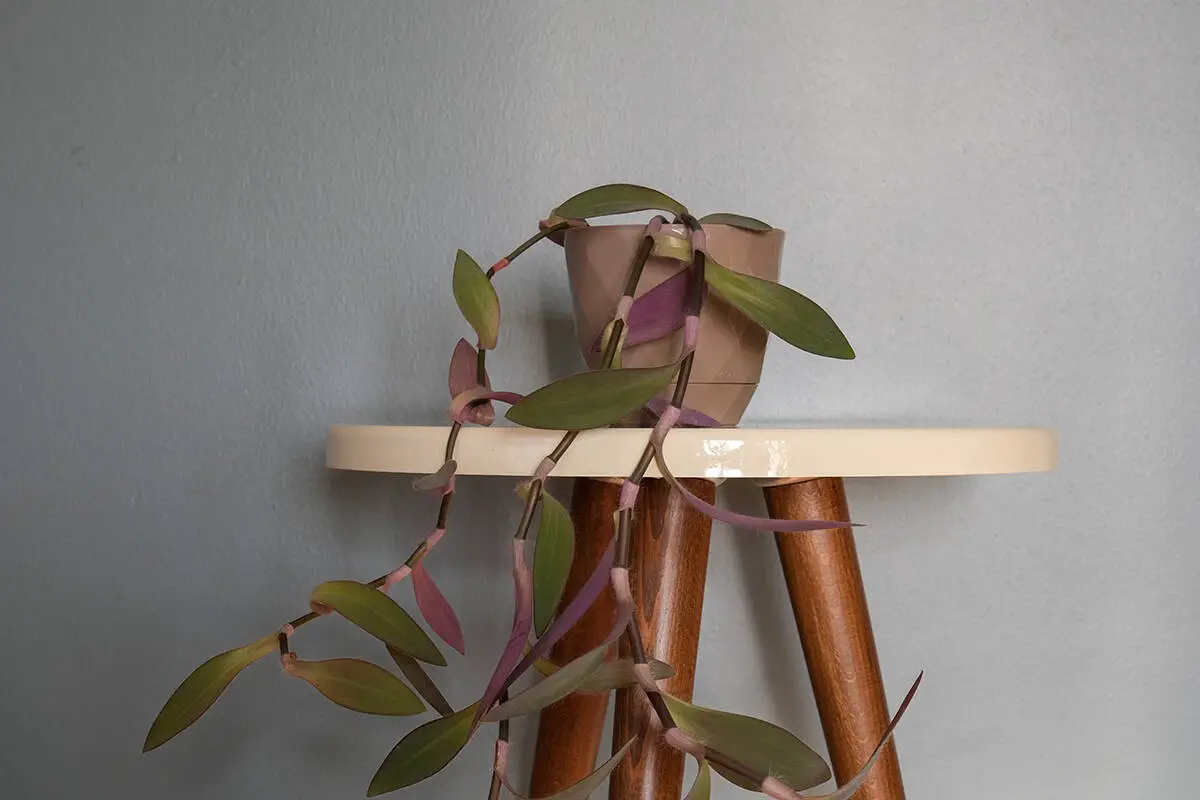
Tradescantia Zebrina is a beautiful trailing houseplant known for its striking foliage. You’ll notice the leaves have green, white, and gray stripes with purple undersides. As a low-maintenance plant, it’s perfect for beginners and experienced gardeners alike.
The plant thrives in bright, indirect light and can tolerate some direct sunlight. Water regularly, allowing the soil to dry slightly between watering sessions. Tradescantia Zebrina is forgiving when it comes to occasional underwatering or overwatering.
One interesting aspect of this houseplant is that it grows well in various environments. You can place it in containers and hanging baskets or use it as an underplanting with larger houseplants, like hibiscus standards, plumeria, or ficus trees. The versatile nature makes it a great addition to your indoor plant collection.
String Of Hearts (Ceropegia Woodii)

The String of Hearts is a popular trailing houseplant that originates from southern Africa. This tender perennial plant belongs to the milkweed subfamily, Asclepiadoideae, and the dogbane family, Apocynaceae. It is prized for its charming and unique appearance, which includes heart-shaped leaves along its trailing stems.
The leaves of this plant have a bluish-green upper surface and display cyclamen-like silver markings. What makes them even more fascinating is their purple hue on the backs of the leaves. Weaving through these leaves, you will find beautiful, small tubular flowers. They start as white and transition to a purplish hue as they age.
Ceropegia Woodii prefers medium light exposure and will thrive in a hanging basket. This makes it an excellent choice for those who are looking for a visually appealing houseplant that is also low-maintenance. As you nurture your String of Hearts, it will provide an alluring addition to your home, creating a warm and cozy atmosphere.
Golden Pothos (Epipremnum Aureum ‘Aureum’)

The Golden Pothos is a popular houseplant in North America. Often called devil’s ivy or hunter’s rove, its scientific name is Epipremnum Aureum ‘Aureum.’
You’ll appreciate the attractiveness of its glossy green or variegated leaves. Growing up to 40 feet in length, Golden Pothos can cascade from hanging baskets, creating a stunning visual effect. Remember not to worry about its growth, as it requires little effort on your part.
For optimum growth, place your Golden Pothos in indirect sunlight and moderate humidity. Be cautious not to overwater this resilient plant; it prefers moist soil but is still able to tolerate drought-like conditions. By providing minimal care, this hardy houseplant will continue to thrive in your home.
In addition to being a decorative addition, the Golden Pothos has an added benefit: it can help purify indoor air. You can be confident in your choice of houseplant, knowing it contributes to a healthier living environment, and provides you with beauty and visual interest.
Swiss Cheese Plant (Monstera Adansonii)
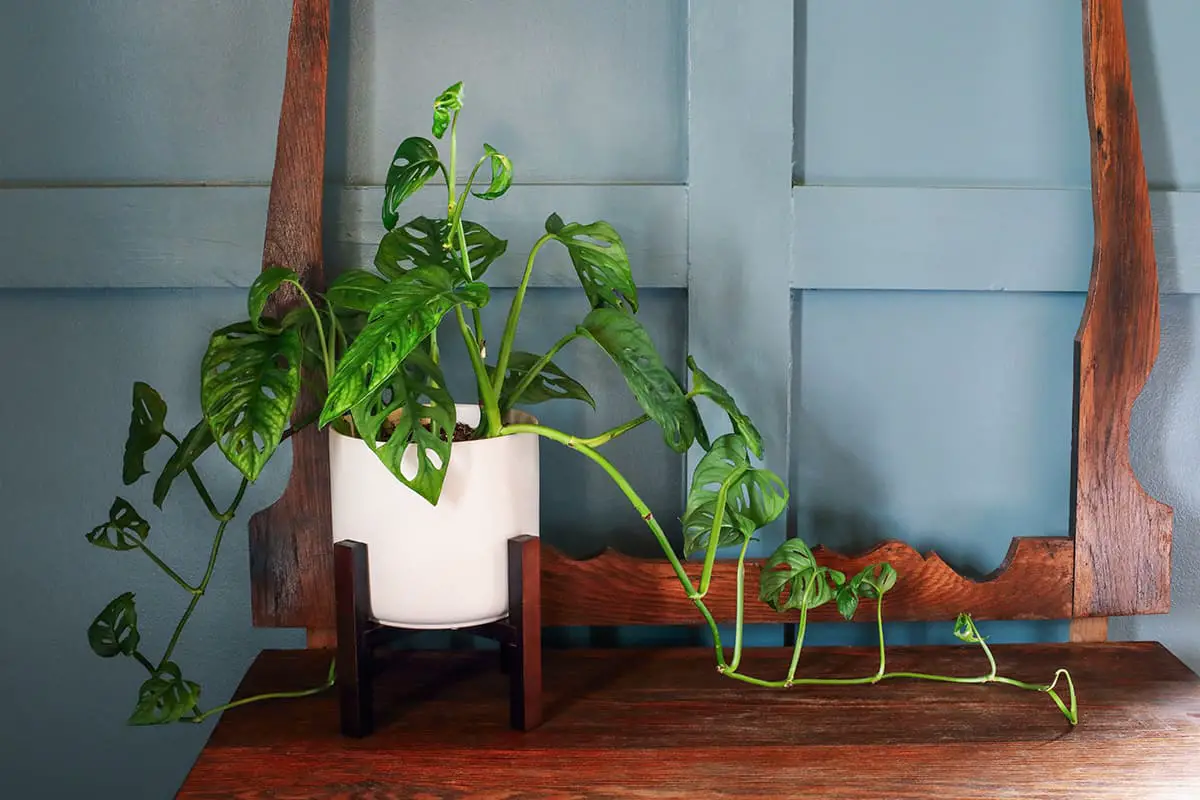
The Swiss Cheese Plant or Monstera adansonii is a popular trailing houseplant known for its distinct, hole-filled leaves. Offering a touch of the tropics, these plants are easy to grow and maintain. You’ll find them perfect for your indoor living spaces.
To nurture your Swiss Cheese Plant, give it a spot with bright, indirect light. Be extra careful to avoid direct sunlight, as it can scorch the plant’s striking leaves. Keep the soil evenly moist, but make sure it’s well-draining to prevent root rot. Remember to maintain high humidity and moderate room temperatures so your Monstera adansonii thrives.
Monstera adansonii benefits from regular fertilization. Feed it with a balanced, diluted liquid fertilizer every month during the growing season. Keep in mind that over-fertilizing can harm your plant. Prune your Swiss Cheese Plant as needed to control its growth and achieve your desired shape. When the plant grows too large, you can propagate it by taking stem cuttings.
As your Swiss Cheese Plant develops, you might notice the trailing vines extending beyond the pot. Make sure to provide it support like a moss pole or trellis for climbing.
Boston Fern (Nephrolepis Exaltata)
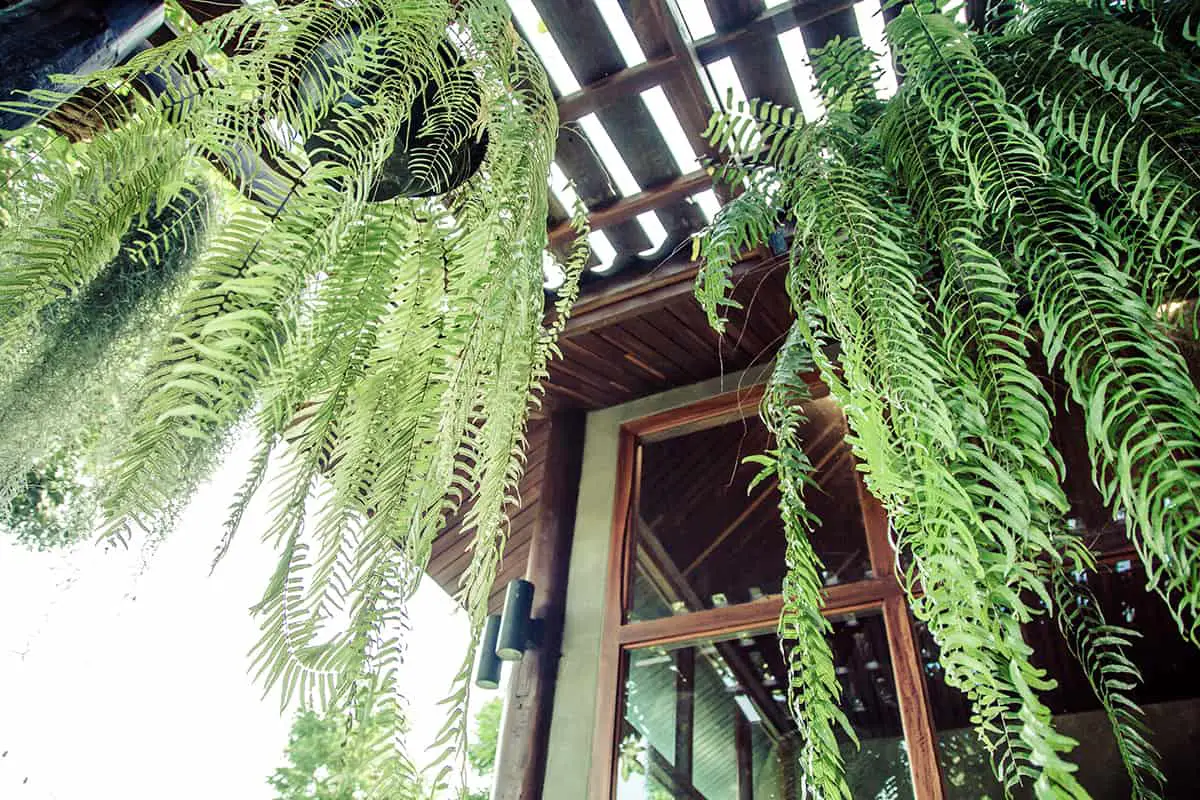
The Boston Fern is a popular trailing houseplant native to humid forests from northern South America through Mexico, in Florida, and the West Indies. Known for its beautiful, arching fronds, it adds a touch of elegance to any indoor space. You’ll appreciate this fern’s air-purifying qualities as it helps remove toxins from your home’s environment.
To maintain the plant’s health, provide it with indirect bright light and a consistent temperature between 60 and 70 degrees Fahrenheit. High humidity is crucial, so it is ideal to place your fern near kitchens or bathrooms. Alternatively, you can set the plant on a tray filled with wet pebbles.
Watering your Boston Fern involves keeping the soil consistently moist, but never drenched. In winter, you may reduce the frequency of watering as the plant’s growth slows down. While nurturing this tropical beauty can be a bit demanding, the benefits of its lush green foliage make the extra effort worthwhile.
To further enhance your Boston Fern’s growth, you can provide it with a balanced liquid houseplant fertilizer every few weeks during the growing season. However, avoid feeding your fern in the winter months.
Peperomia Prostrata (String of Turtles)
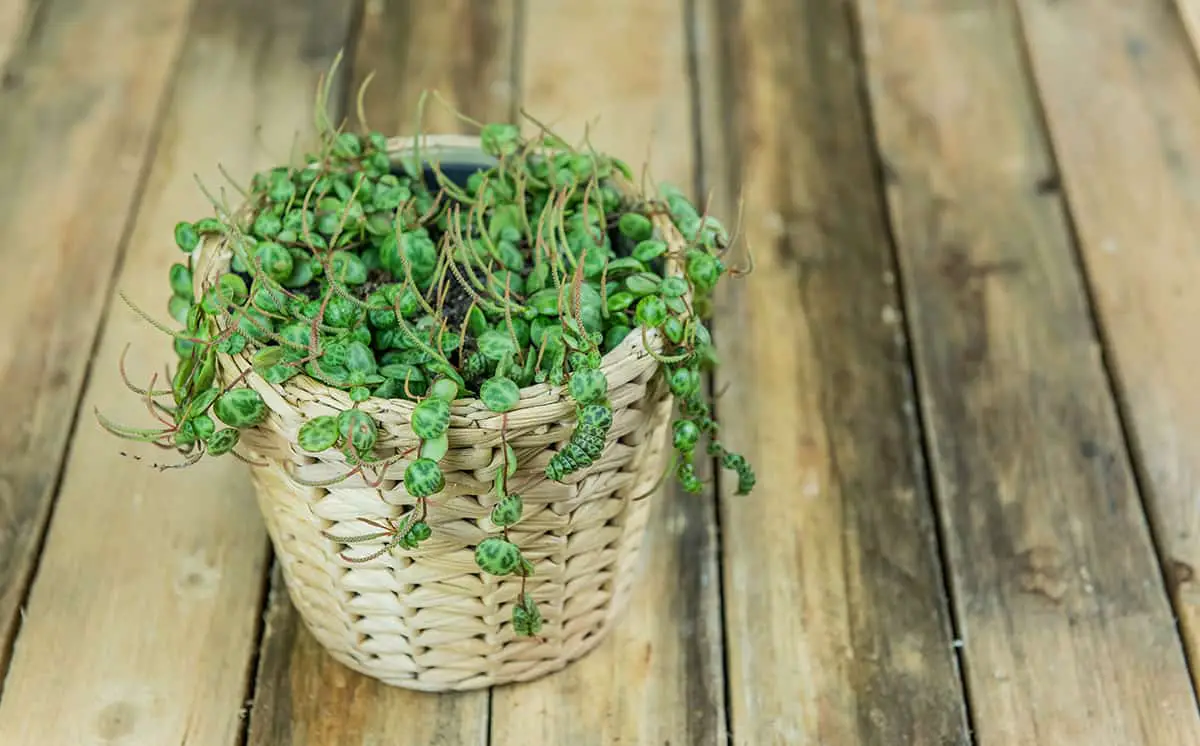
The Peperomia Prostrata is a delightful trailing houseplant, also known as the String of Turtles. With its delicate vines and round, succulent variegated leaves, this plant adds character to any indoor space.
As an owner, you should provide bright, indirect light to keep your String of Turtles healthy. Avoid direct sunlight, as it may damage the leaves. When it comes to watering, it’s essential to strike a balance. You should let the soil dry out slightly before watering but avoid letting it become completely dry.
This plant tends to thrive in indoor temperatures between 65°F to 75°F (18°C to 24°C) and prefers humidity levels around 50%. Keeping your plant in an area away from drafts and sudden temperature changes will ensure a healthy growth. If you notice that the air is too dry, you may want to consider using a humidity tray or misting the leaves.
When it comes to repotting, keep in mind that Peperomia Prostrata doesn’t have an aggressive growth habit. As a result, you won’t need to repot frequently – only when the current pot becomes too small or the plant starts showing signs of stress. Be sure to use a well-draining soil mix, as overwatering can lead to root rot.
Adding a String of Turtles to your collection, either in a terrarium, outdoor container, or hanging basket, can be a charming choice.
Satin Pothos (Scindapsus Pictus)
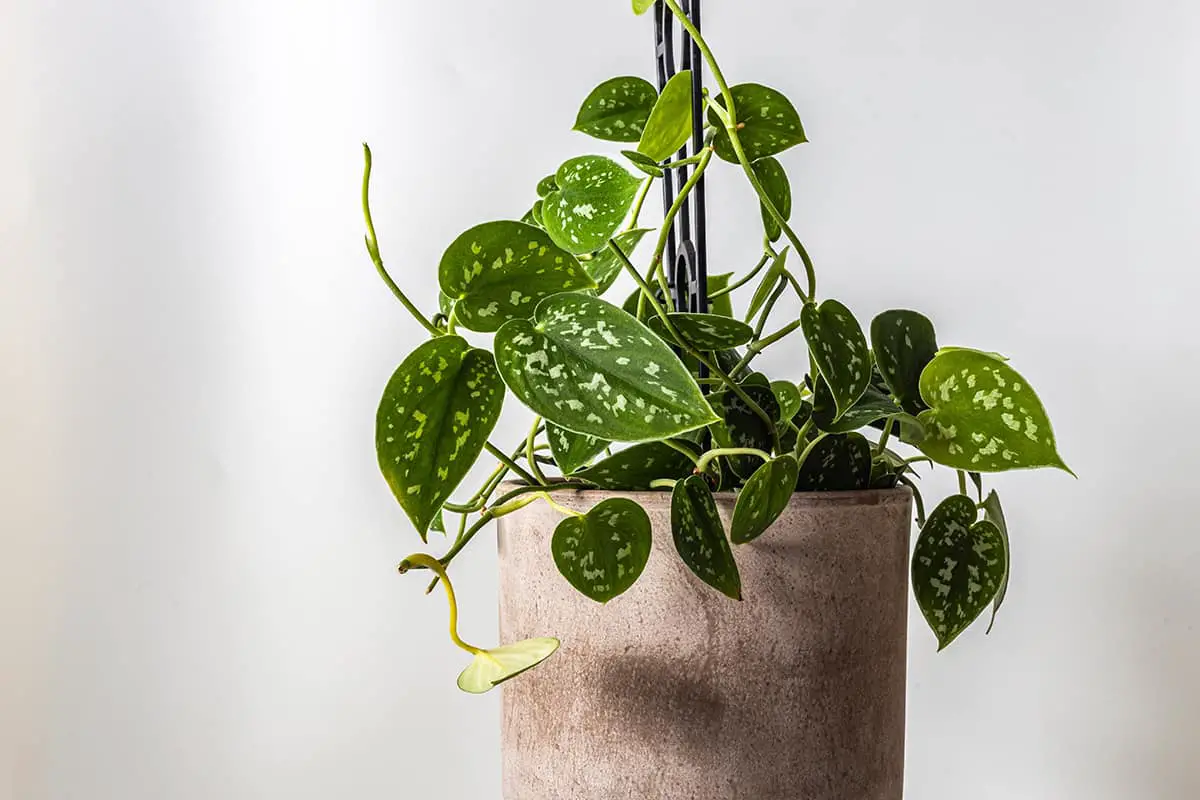
Satin Pothos, also known as Scindapsus Pictus, is an evergreen vine with beautiful, variegated dark green and silvery leaves. This tropical plant is native to Southeast Asia and has become a popular houseplant choice due to its attractive appearance and easy care requirements.
To help your Satin Pothos thrive, provide it with filtered light and avoid direct sunlight. As a tropical plant, it prefers warmer temperatures and high humidity. You can place your plant near a window with indirect light or even in rooms with artificial light. It is also important to keep the soil moderately moist but be careful not to overwater it, as this can cause root rot.
Another notable feature of the Satin Pothos is its ability to grow well in hanging baskets. As the plant matures, its vines will trail down, creating an appealing cascading effect. This makes it an excellent choice for areas where floor space is limited or where you want to create a visual focal point with a trailing houseplant.
When it comes to propagation, Satin Pothos is relatively simple to propagate through stem cuttings. Just snip a section of the stem with at least one or two leaves, place the cutting in water, and wait for new roots to emerge. Once roots are established, transfer the cutting to a pot filled with well-draining potting soil.
Keep in mind that Satin Pothos, like other members of the Arum family, can be toxic to pets and humans if ingested. So, it’s essential to place your plant in an area where curious pets or children won’t be able to reach it.
Chain Of Hearts (Ceropegia Woodii Variegata)
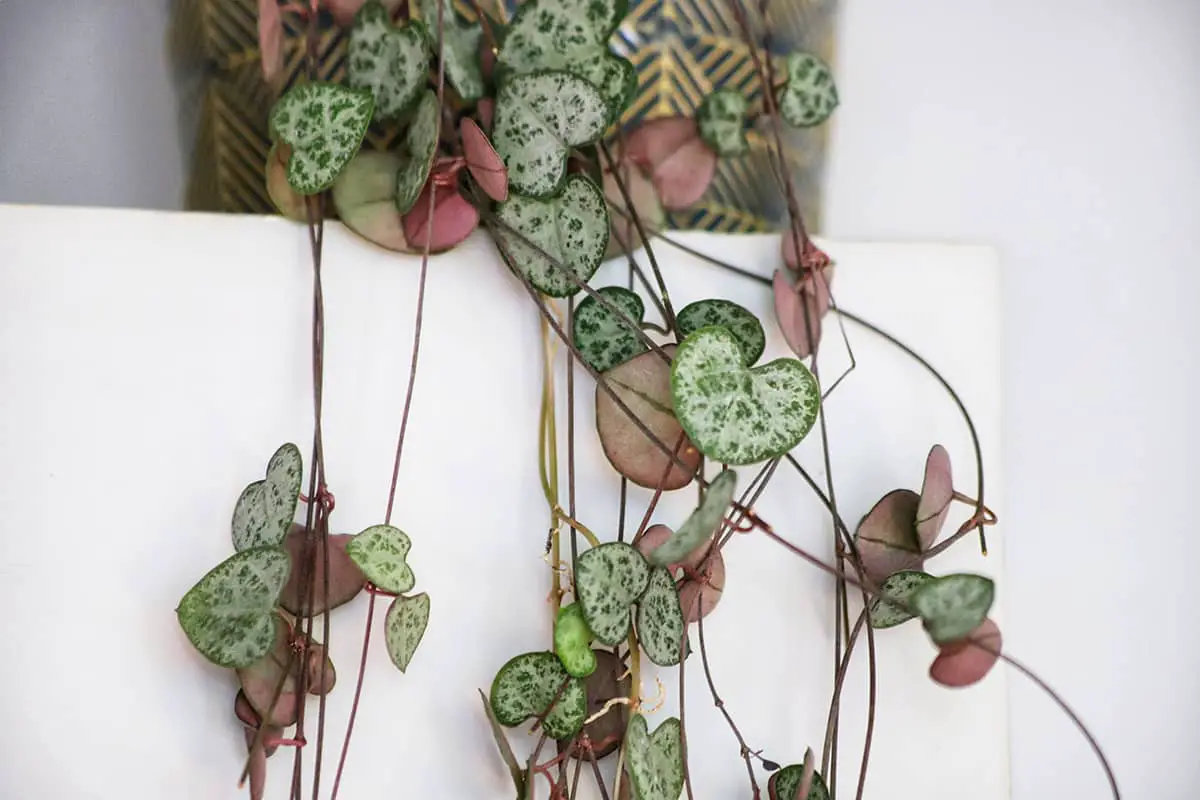
The Chain of Hearts (Ceropegia Woodii Variegata) is a popular trailing houseplant you’ll love for its distinct appearance. Native to southern Africa, this captivating plant features delicate heart-shaped leaves with a beautiful variegated pattern. The leaves display a mix of green, white, and silver, adding a unique touch to your indoor space.
To provide optimal growing conditions, ensure your plant receives bright, indirect light. Keep it near a north or east-facing window, as direct sunlight may scorch the leaves. You’ll find the ideal temperature to be between 65 and 80 degrees Fahrenheit. Avoid exposing your plant to temperatures lower than 60 degrees Fahrenheit, as it may cause stress and hinder its growth.
When it comes to watering, it’s essential to maintain a balance. The Chain of Hearts prefers its soil to be moderately moist but well-drained. Overwatering may lead to root rot, while underwatering can cause leaf drop. A good rule of thumb is to soak the soil thoroughly and then allow the top half to dry out before watering again.
Fertilizing your Chain of Hearts plant is necessary to encourage healthy growth. During the Spring and Summer, use a diluted liquid fertilizer once every four weeks for optimal results. However, in the Fall and Winter months, reduce its feeding schedule, as the plant enters a period of dormancy.
Hoya (Hoya Carnosa)
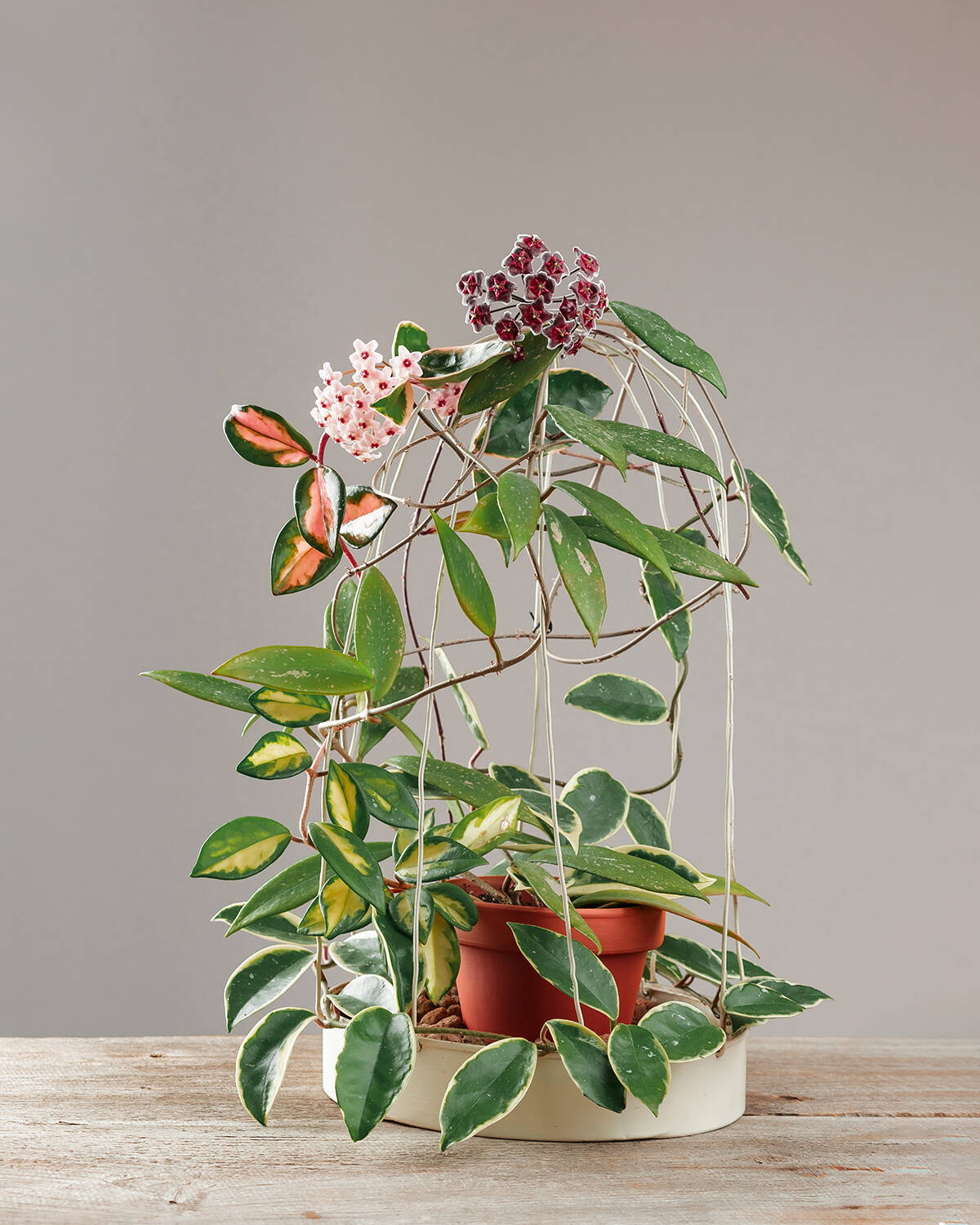
Hoya plants, also known as wax plants, are popular trailing houseplants because of their attractive and glossy leaves. They belong to the Hoya carnosa species, and are native to India, Asia, Australia, and the Pacific islands. In this section, we will explore their characteristics and care requirements for a thriving indoor plant.
Hoya carnosa is admired for its sweet-smelling, star-shaped flowers that bloom in clusters. These plants are easy to care for and come in different varieties, such as Hoya carnosa ‘Crispa’ and ‘Regalis.’ The leaves of some varieties have curled or twisted stems, often referred to as rope plants.
They can tolerate low light, but for better growth and flowering, they need medium to high light. During the winter months, it is essential to maintain a slightly cooler and drier environment. To avoid disturbing the plant, do not move it once it’s placed in a suitable spot.
Make sure to water the plant moderately and allow the soil to partially dry before the next watering. Hoyas are not heavy feeders, so a balanced liquid fertilizer can be applied every couple of months during the growing season.
Burro’s Tail (Sedum Morganianum)
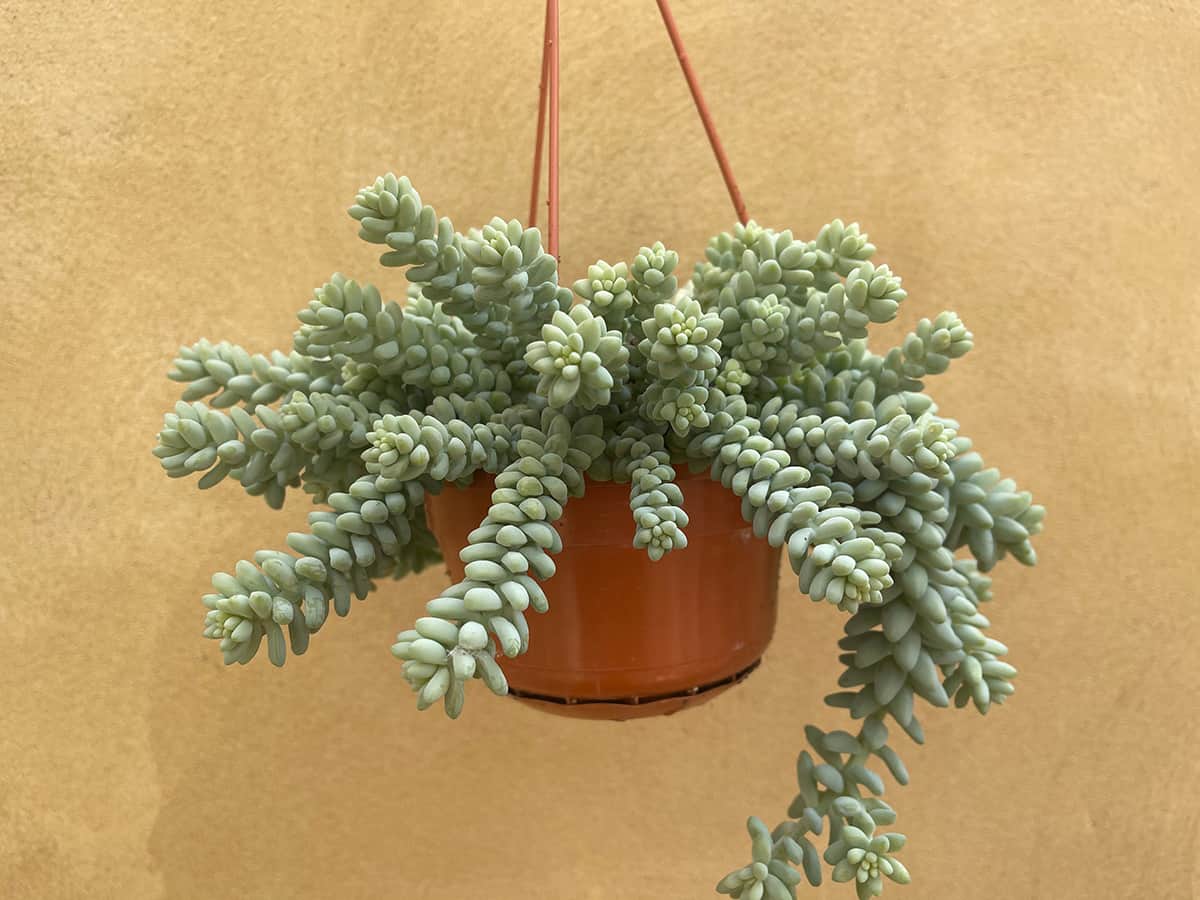
Burro’s Tail is a popular trailing houseplant with unique, eye-catching foliage. It belongs to the succulent family and is known by its scientific name, Sedum morganianum. You can easily identify this plant by its trailing stems that resemble an animal’s tail, covered in triangular-shaped, blue-green leaves.
This low-maintenance houseplant thrives in bright, indirect light and requires well-draining soil. Due to its delicate leaves that tend to break off easily, avoid placing it in areas with heavy foot traffic or where it might be accidentally brushed against. One of the best ways to showcase Burro’s Tail is by using a hanging container, allowing its trailing stems to take center stage. Moreover, its unique feature of water-storing leaves enables it to withstand drought better than other plants.
Sedum morganianum has a long history as a tropical ornamental with a variety of common names, such as donkey’s tail, horse’s tail, and lamb’s tail, all owing to the resemblance of its trailing stems. While being part of the large Sedum genus, Burro’s Tail stands out as one of the most elegant and alluring options for your indoor garden.
Rhipsalis (Rhipsalis Baccifera)
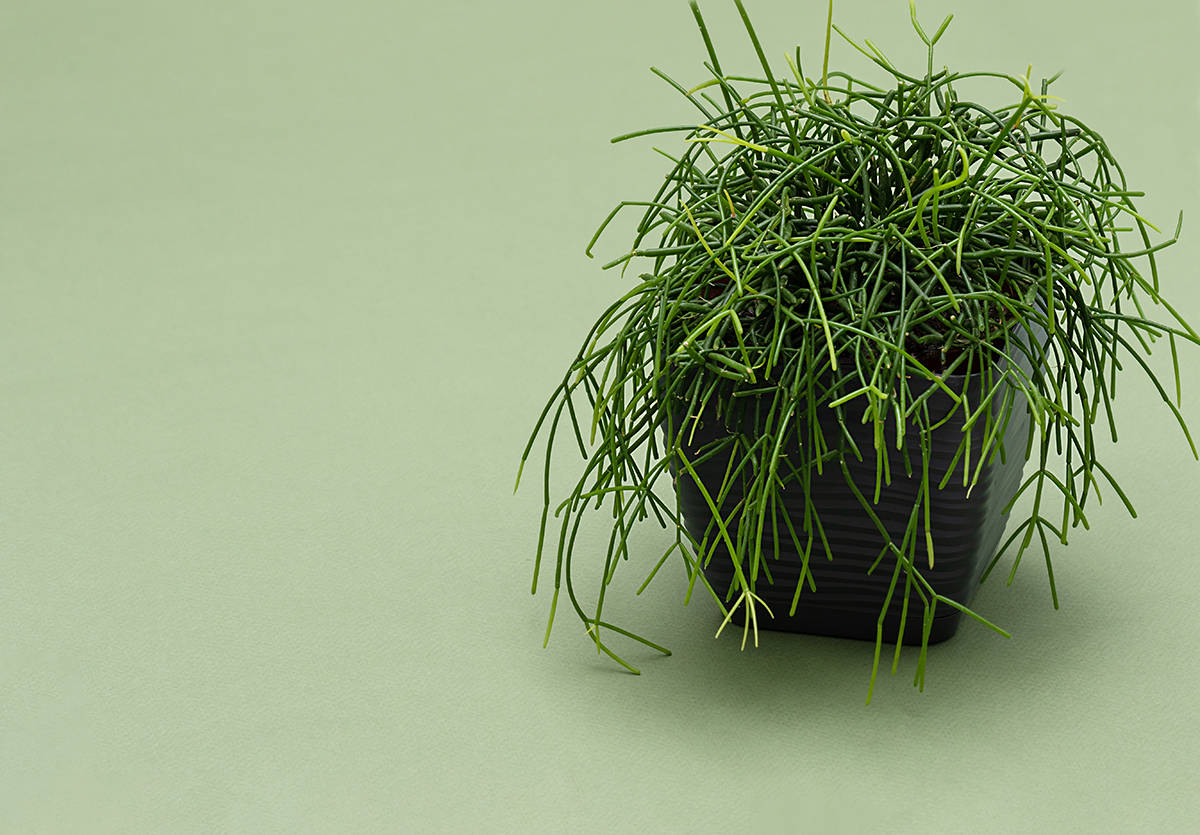
Rhipsalis, commonly known as the Mistletoe Cactus, is an excellent choice for a trailing houseplant. It is an epiphytic cactus with distinctive features and minimal care requirements. You can easily create an eye-catching display by placing your Rhipsalis in a hanging planter or on a high shelf.
Rhipsalis Baccifera is a non-toxic plant, making it a safe choice for households with pets or small children. Its hanging, pencil-like stems give it an uncommon appearance compared to other houseplants. In mild conditions, it can produce small, white flowers and tiny berries that add a touch of elegance to your home decor.
To ensure optimal growth, place your Rhipsalis in an area with bright, indirect light. Avoid exposure to direct sunlight, as it can cause the plant’s delicate leaves to scorch. Since Rhipsalis is an epiphytic plant, it is essential to keep its soil slightly moist but well-drained. Overwatering can lead to the roots rotting, so let the top layer of soil dry before watering again.
Arrowhead Plant (Syngonium Podophyllum)
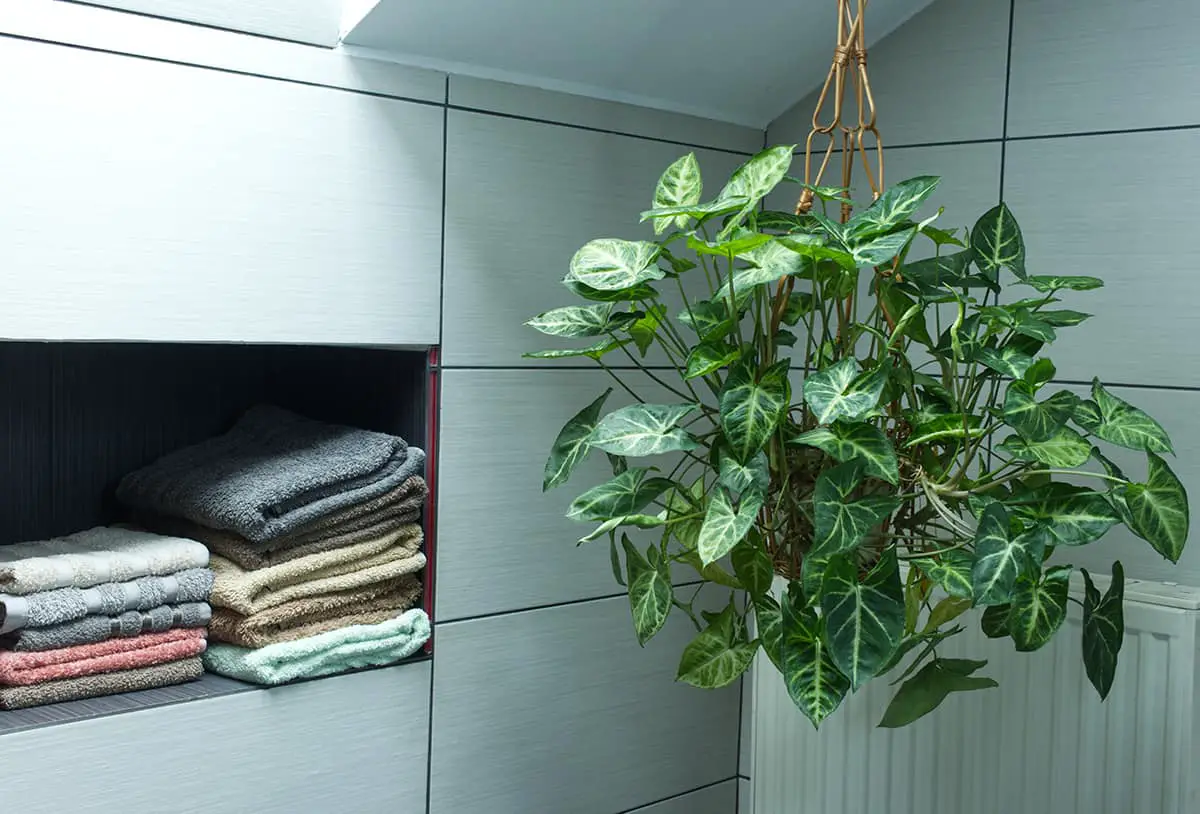
The Arrowhead Plant, scientifically known as Syngonium Podophyllum, is a popular trailing houseplant. This tropical plant boasts arrow-shaped leaves and a wide array of colors. Adapting well to indoor environments, the Arrowhead Plant is a charming addition to your home.
Caring for your Arrowhead Plant is relatively easy. They flourish in medium to low light levels. Moreover, always keep the soil moderately moist but never waterlogged. Remember to provide your plant with proper humidity by either misting or using a humidifier. Regular pruning helps maintain a bushy, shrub-like growth habit.
When it comes to propagating the Arrowhead Plant, stem cuttings are the way to go. Simply snip off a healthy stem, remove the lower leaves, and place it in water. In a few weeks, roots will emerge, and your new plant will be ready to be transferred to the soil.
Maidenhair Vine (Muehlenbeckia Complexa)
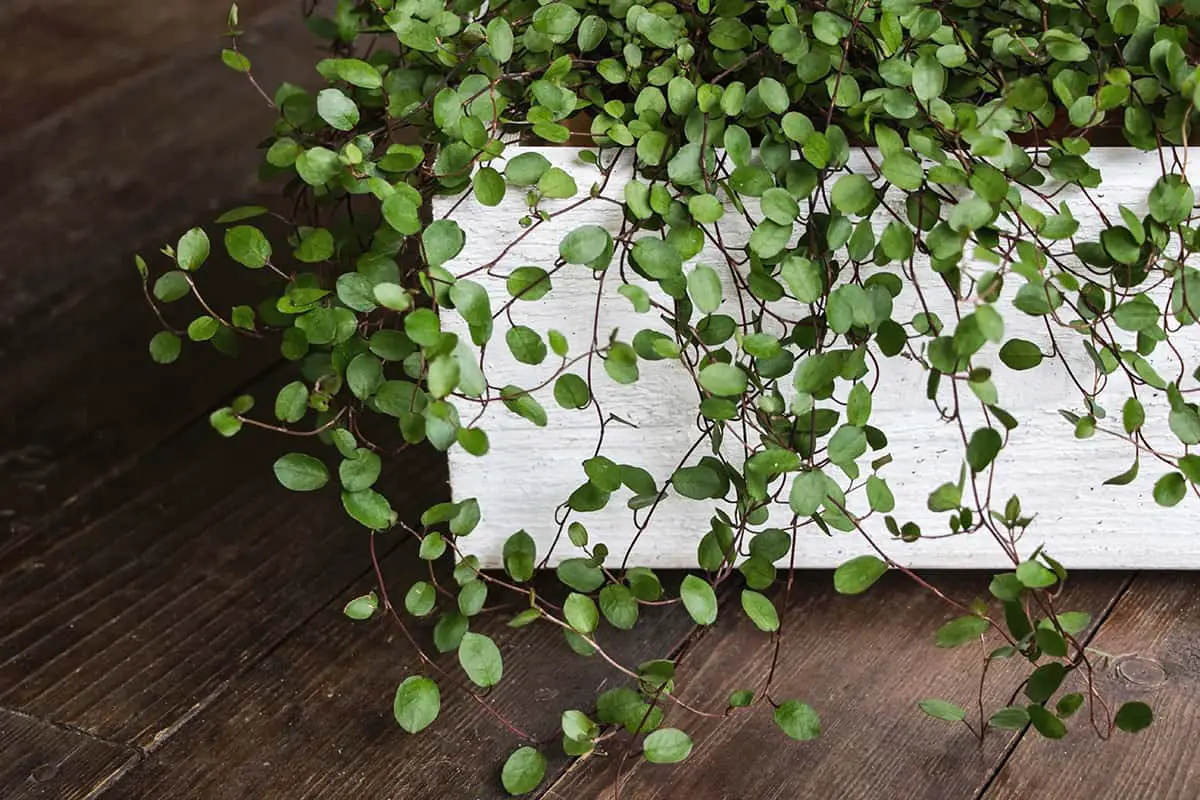
Maidenhair Vine, also known as Muehlenbeckia Complexa, is a trailing houseplant that captivates your attention with its delicate foliage. As you bring it into your home, you will appreciate the glossy leaves and fast growth rate.
When considering where to place your Maidenhair Vine, remember it prefers bright indirect light. One of its benefits is that it can tolerate a range of environments, including being frost tolerant and salt spray tolerant. Additionally, this plant creates stunning visuals when placed in hanging baskets or containers.
To care for your Maidenhair Vine, make sure to provide it with proper watering and well-drained soil. Overwatering can cause your plant to suffer, so it’s best to allow the soil to dry slightly between watering. Regular pruning will help maintain its beautiful appearance, as this plant can become aggressive in growth.
Wandering Jew (Tradescantia Pallida)
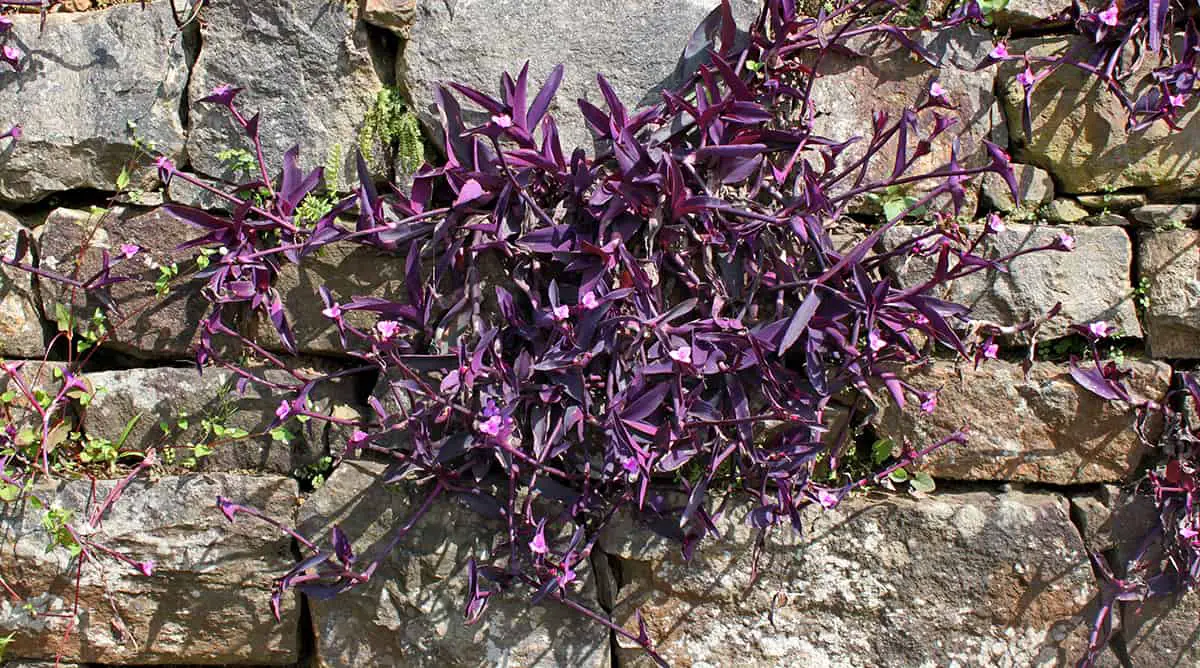
Tradescantia pallida, commonly known as the Wandering Jew, is a tender perennial houseplant valued for its attractive trailing purple stems. With striking violet-purple leaves and charming pink flowers, this plant adds a touch of color to your living space during its summer flowering period. Though it is typically grown as an annual, the plant may return in protected areas or mild winters.
In your care routine, be sure to provide your Wandering Jew with bright, indirect light for optimal growth. When it comes to watering, let the soil slightly dry out before watering again. Don’t worry if you miss a watering session, as this plant is quite forgiving and can tolerate brief periods of drought.
One of the main attractions of this houseplant is its ease of propagation. The succulent stems easily root wherever they touch the soil, making it simple for you to expand your collection or share cuttings with friends. Additionally, Wandering Jew thrives in a variety of environments, from hanging baskets to ground cover, showcasing its versatility as a houseplant.
Keep an eye out for pests, as the Wandering Jew is occasionally susceptible to spider mites and aphids. Regularly inspect the foliage and stems to catch any potential issues early on.
String Of Nickels (Dischidia Nummularia)
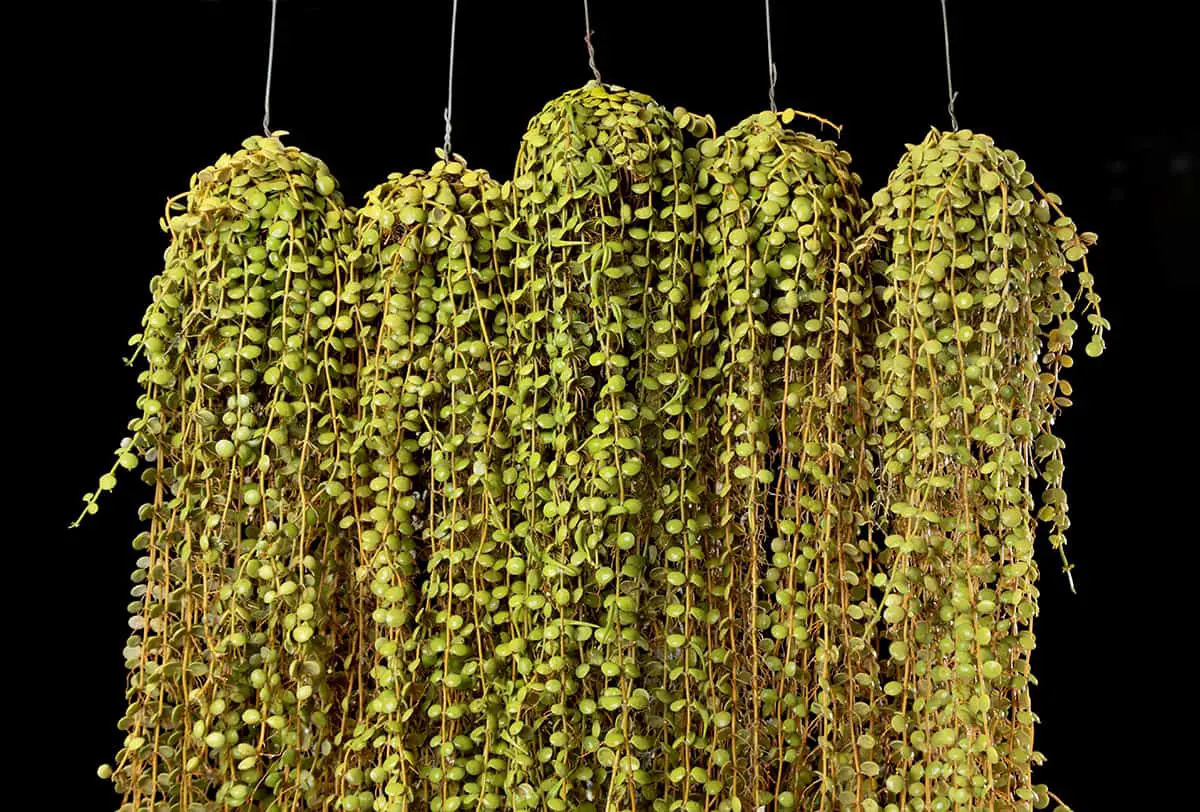
The String of Nickels (Dischidia Nummularia) is a unique and eye-catching trailing houseplant that deserves a spot in your collection. This plant is native to tropical regions of Asia and can be a great addition to your indoor garden.
As its name suggests, this plant features small, round leaves that resemble shiny nickels or coins. The leaves are often dark green, sometimes with a hint of silver.
Caring for the String of Nickels is straightforward. First, make sure you provide bright, indirect light for your plant. It can tolerate medium light, but avoid direct sunlight as it can burn the leaves. Keep the temperature between 60-80°F (15-27°C) and maintain humidity levels above 50% by placing the plant near a humidifier or using a pebble tray with water.
Ensure regular, yet not excessive, watering for your plant. Wait for the soil to dry slightly before providing water again to avoid overwatering. Be extra cautious during winter months, as the need for water decreases in cooler temperatures. The plant can be easily propagated by taking stem cuttings and placing them into a moist potting mix.
String of Nickels can be susceptible to common houseplant pests like mealybugs, so inspect your plant regularly for signs of infestation. In case you notice any pests, remove them with a cotton swab dipped in rubbing alcohol and take measures to prevent their return.
